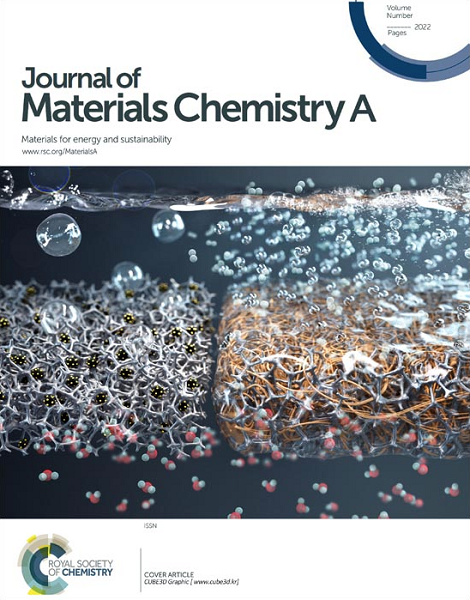One Nanometer Matters: Quantum-Induced Discontinuity in the Oxygen Reduction Reaction Catalyzed by Platinum Nanoparticles
IF 9.5
2区 材料科学
Q1 CHEMISTRY, PHYSICAL
引用次数: 0
Abstract
Quantum-induced discontinuity in the oxygen reduction reaction (ORR) catalyzed by Pt nanoparticles (NPs) occurs at the ~1.0 nm scale. Using a controlled solution plasma method, we synthesized monodisperse, surfactant-free ~1.0-nm Pt NPs uniformly supported on single-walled carbon nanotubes. Electrochemical evaluation revealed a pronounced deviation from the classical size-scaling behavior: the catalytic activity decreased with decreasing Pt NP diameter from 2.5 to 1.5 nm but unexpectedly increased at ~1.0 nm. High-resolution structural and spectroscopic analyses confirmed a critical transition around 1.5 nm, which separates the classical metallic behavior from a regime governed by quantum confinement. Despite their partial structural disorder, these quantum-sized clusters exhibited superior ORR performance, attributed to discrete electronic states, altered d-band structures and a high density of low-coordination active sites. The catalysts also demonstrated high durability, retaining ~90% of its reduction current after 2,000 cycles with <5% particle growth in acidic media. In particular, the superior ORR performance at ~1.0 nm is consistent with the formation of magic number clusters exhibiting high symmetry, closed shell stability, and facet-specific reactivity. These structures deviate from conventional crystal habits, favoring icosahedral or truncated geometries rich in undercoordinated edge and corner atoms. The resulting disruption of long-range order and emergence of localized quantum states redefines the catalytic paradigm at this scale. This abrupt improvement in ORR performance establishes a fundamental boundary between classical and quantum electrocatalysis. By reframing ultrasmall Pt NPs as quantum objects rather than miniature metals, this study introduces a new design principle: harnessing quantum effects and symmetry-driven structural motifs for the rational design of next-generation catalysts in sustainable energy technologies.一纳米物质:铂纳米粒子催化氧还原反应的量子诱导不连续
Pt纳米粒子(NPs)催化的氧还原反应(ORR)在~1.0 nm发生了量子诱导的不连续。采用控制溶液等离子体法,我们合成了单分散、无表面活性剂的~1.0 nm纳米铂,均匀地负载在单壁碳纳米管上。电化学评价揭示了与经典尺寸尺度行为的明显偏差:随着Pt NP直径从2.5 nm减小到1.5 nm,催化活性下降,但在~1.0 nm时却意外地增加。高分辨率的结构和光谱分析证实了一个大约1.5 nm的临界跃迁,它将经典金属行为与量子约束区分开。尽管它们的部分结构无序,但这些量子大小的团簇由于离散的电子态、改变的d带结构和高密度的低配位活性位点而表现出优异的ORR性能。催化剂还表现出很高的耐久性,在酸性介质中,当颗粒生长<;5%时,在2000次循环后仍能保持约90%的还原电流。特别是,在~1.0 nm处优越的ORR性能与形成具有高对称性、闭壳稳定性和面特异性反应性的幻数团簇相一致。这些结构偏离了传统的晶体习惯,倾向于二十面体或截断几何形状,富含欠配位的边缘和角落原子。由此产生的远程秩序的破坏和局域量子态的出现重新定义了这个尺度上的催化范式。ORR性能的突然改善建立了经典电催化和量子电催化之间的基本界限。通过将超小型Pt纳米粒子重新构建为量子物体而不是微型金属,本研究引入了一种新的设计原则:利用量子效应和对称驱动的结构基元来合理设计可持续能源技术中的下一代催化剂。
本文章由计算机程序翻译,如有差异,请以英文原文为准。
求助全文
约1分钟内获得全文
求助全文
来源期刊

Journal of Materials Chemistry A
CHEMISTRY, PHYSICAL-ENERGY & FUELS
CiteScore
19.50
自引率
5.00%
发文量
1892
审稿时长
1.5 months
期刊介绍:
The Journal of Materials Chemistry A, B & C covers a wide range of high-quality studies in the field of materials chemistry, with each section focusing on specific applications of the materials studied. Journal of Materials Chemistry A emphasizes applications in energy and sustainability, including topics such as artificial photosynthesis, batteries, and fuel cells. Journal of Materials Chemistry B focuses on applications in biology and medicine, while Journal of Materials Chemistry C covers applications in optical, magnetic, and electronic devices. Example topic areas within the scope of Journal of Materials Chemistry A include catalysis, green/sustainable materials, sensors, and water treatment, among others.
 求助内容:
求助内容: 应助结果提醒方式:
应助结果提醒方式:


